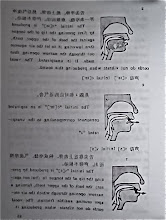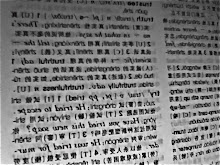There are countless collections of the origins of curious words and phrases gathering dust on bookshelves until some vulnerable reader, much like myself, falls prey to their novelty. But, in The Space Between Three Violins, I am less interested in the immediately recondite and esoteric than I am in the quotidian, which hoards a trove of exotic treasures beneath its membrane. Our first etymologies, therefore, are nearly as plain as they come: eleven and twelve.
Eleven derives from—and I am taking some typographic license for the ease of transliteration—the Germanic ainlif, meaning, quite literally, "one left." Twelve exhibits the same, deriving from the Germanic twalif, or "two left." Note that we can easily supply eleven's sense of "one left over from ten," as well as twelve's "two left over from ten," to understand the forms of these number words. And, in case you wanted to know, ain we can trace comfortably to the Proto-Indo-European (PIE) oinos; two from the PIE duwo. Lif, moreover, emerges from the PIE leiwk.
But it is not that parts that concern me here. It's the rarity of the construction. I have only encountered one other language that demonstrates such construction—Lithuanian, a peculiarly wonderful member of Baltic phylum of the Indo-European languages. From eleven to nineteen in Lithuanian, witness a PIE cognate + lika (as in "left"), whose origin, note, comes from the aforementioned leiwk. A few examples: vieunolika (eleven), dvylika (twelve), trylika (thirteen), and so on.
So, what strikes me as so unusual about the construction? For starters, outside of the Lithuanian counterpart, eleven and twelve are the only number words that contain a "pure" number word with a verb—in this case a past participle. Please correct me if I am mistaken, but every other language that I have researched and can think of handles numbers above 10 with a combination of number word + number word. For example, eleven as a "ten-one" construction.
How did the "one left" and "two left" configurations enter into German and thus English as such? Why just these two? Why were the rest of the "teen's" exempt from this formation? What kind of contact between Baltic and Germanic peoples potentially occurred for, I hypothesize, a cross-pollination?
To me, there is something so different about uttering "one left over (from ten)" than "ten-one." What is it? I am not quite sure. Perhaps it exposes the primacy of the number 10 in the human mind. What in our evolution—physically, psychologically, linguistically—privileged this number so nearly universally? Why is it groups of 10 that we think in, figure in, navigate time and space in?
There is also something so beautifully tactile about ainlif and twalif. Their etymologies provide a rich image of man before objects (sticks, stones, shells, fruit), counting them, separating them, putting them into neat, comprehensible piles. Man's primal urge to categorize, organize, to make sense of the world, the cosmos, through groups of stuff, things, food, tools, building materials near man's opposable-thumb reach.
And that's why eleven and twelve, obscure in their origins as they may be, are so alive, concrete, historical, tangible.



Thanks to Matt B., etymononline.com (a fun, easy, and useful site I recommend you visit), and http://debeselis.net/numbers.php for some of the linguistic details.
ReplyDeleteI too was struck by the immediacy of "one left" and "two left" and had the same thoughts of Germanic dudes dividing things up into piles of 10 and having ain or twa lif. I would take issue with the idea that 10 has some kind of underlying psychological primacy though. 12 (4 fingers x 3 segments counted with the thumb on each hand) has always been kind of a big deal because of its many factors and concomitant ease of multiplication/ division. And — despite the best efforts of the French Republicans — it is still pretty important if you're telling time. 20, the preferred base of the Celts, among others, still makes its influence felt from time to time as well. Like when you spend €80 in Paris and whenever you read the Gettysburg Address. Various cultures at various times have also used base 4, 5, 8 and even 60 (4 fingers x 3 segments x 5 digits on the other hand) systems, and each has their relative advantages. In my Germanic heart of hearts, I think I prefer base 12, with its warm, organic feet and ounces and whatnot. Base 10 and its SI spawn has always struck me as kind of detached and cold, like trying to impose an artifical order from outside. Although I will readily concede that using base 12 units of measurement when you count in base 10 is a bitch and a half. If I haven't already said too much (I have), my best, uneducated guess as to why there's no *niunlif or somesuch is that somewhere in PIE-speaking Eurasia, there were some people who referred to 1-9 left over from ten, twenty etc. and some people who just said nine-and-ten, four-and-twenty, etc. and they met and mingled and one got more popular and now only eleven and twelve are there from the less popular system.
ReplyDeleteP.S. William Safire is on vacay, so there is a great "On Language" in the NYT Sunday Magazine about weird dictionary definitions: http://www.nytimes.com/2009/08/16/magazine/16FOB-onlanguage-t.html?ref=magazine
Thanks for your very informative thoughts on 10. I, too, think 12 is the bigger deal, as it is the number of time and due to its richness as a composite number.
ReplyDeleteAnd on the note of the many exceptions which I overlooked, I came across the New Guinea languages Huli, which uses a system based on 15, and Ndom, which uses a system based on 6. You must check out and spend some time with this scholar's wonderful collection of linguistic number systems: http://www.sf.airnet.ne.jp/~ts/language/number.html.
Now that we have acknowledged the variety of human counting systems, I must ask a few Socratic questions. 10 may not have said primacy numerically speaking, but why is it that 10 has become so sedimented into language? Why is 10 so prevalent, even across disparate language families, as the reference point? Even the variations on -ty (as in twenty) across languages points to the 10 as the frame of reference, in language. Is this the chance product of the contact of historical peoples where the 10-based cognates won out?
Thoughts?
10 is all around us, isn't it? Why? I don't know. I mean, we've got 10 fingers; that is abundantly clear, but if that were the only reason, it seems like other integer bases would never have developed at all. It seems tendentious in the extreme to argue that the Celts or the Ndom are somehow less in touch with the human condition such that they would forgo 10 entirely. After a lot of thought I really do come out with random chance being the Occam's Razor solution to this conundrum, especially given that the various constants and ratios in math and physics (π, e, φ, etc.) are, pretty much all irrational numbers, and that the factors of the speed of light, for example, are 2 and 7. I can't really see any cosmic significance for 10 coming out of that mess. Why it ended up being independently settled on by so many different cultures probably does have something to do with those "digits" (cf. etymology thereof) radiating from our hands. It certainly is the more obvious route to take, visually speaking, than counting finger segments or toes or whatever else. I'm a little surprised that more cultures don't use squares as their bases, since that would make for more aesthetically pleasing organization when you're sorting your possessions. I wonder too if we wouldn't be having the same conversation about 8 or 12 or 20 if we were used to one of those. There are all kinds of arguments you could make up (the dominant gene in the matter of digits codes for 6 fingers/hand, say). In the end I'm afraid we'll have to continue on in awesome wonder at the every day things we can never know.
ReplyDelete